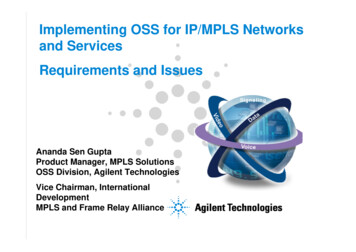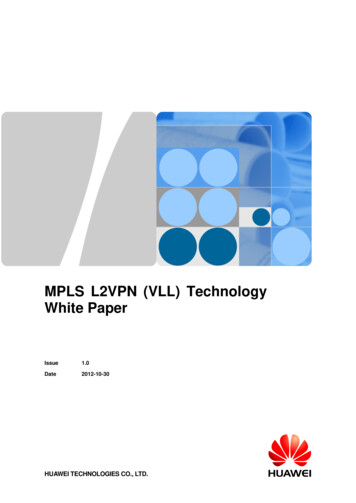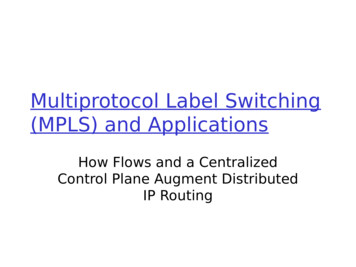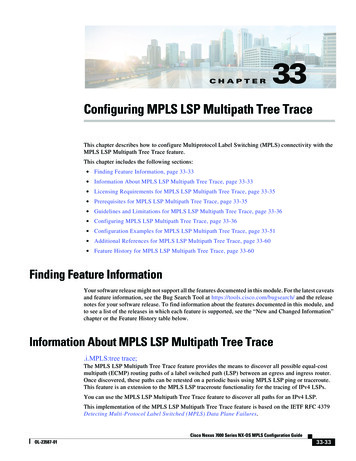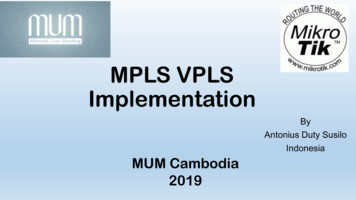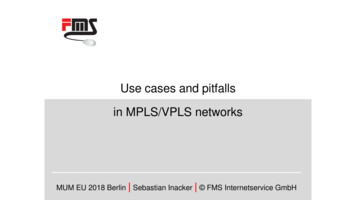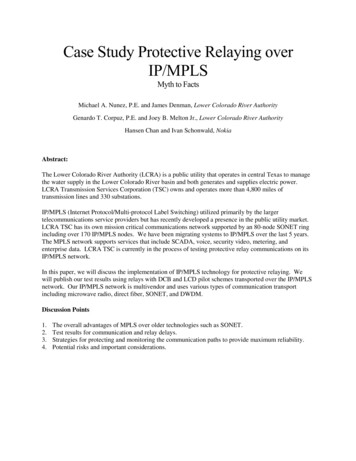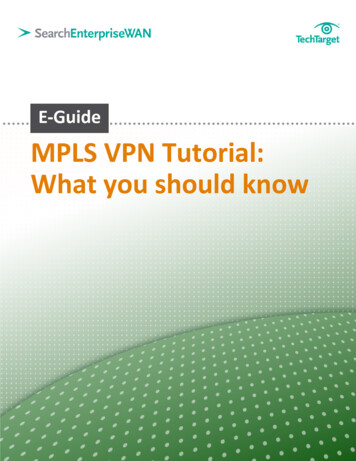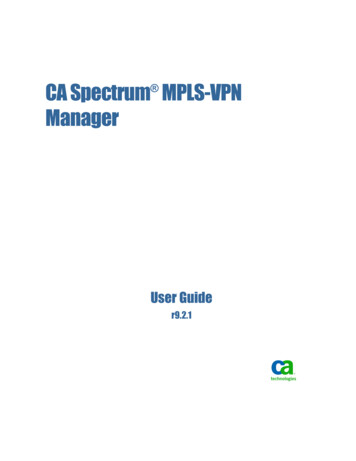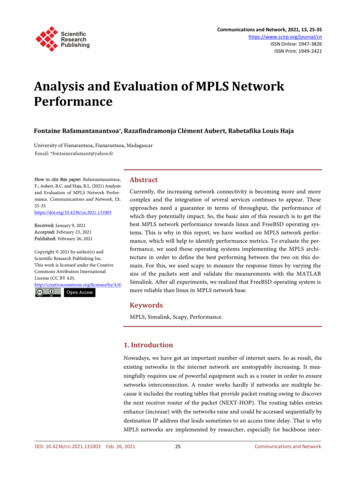
Transcription
Communications and Network, 2021, 13, 25-35https://www.scirp.org/journal/cnISSN Online: 1947-3826ISSN Print: 1949-2421Analysis and Evaluation of MPLS NetworkPerformanceFontaine Rafamantanantsoa*, Razafindramonja Clément Aubert, Rabetafika Louis HajaUniversity of Fianarantsoa, Fianarantsoa, MadagascarHow to cite this paper: Rafamantanantsoa,F., Aubert, R.C. and Haja, R.L. (2021) Analysisand Evaluation of MPLS Network Performance. Communications and Network, eived: January 9, 2021Accepted: February 23, 2021Published: February 26, 2021Copyright 2021 by author(s) andScientific Research Publishing Inc.This work is licensed under the CreativeCommons Attribution InternationalLicense (CC BY en AccessAbstractCurrently, the increasing network connectivity is becoming more and morecomplex and the integration of several services continues to appear. Theseapproaches need a guarantee in terms of throughput, the performance ofwhich they potentially impact. So, the basic aim of this research is to get thebest MPLS network performance towards linux and FreeBSD operating systems. This is why in this report, we have worked on MPLS network performance, which will help to identify performance metrics. To evaluate the performance, we used those operating systems implementing the MPLS architecture in order to define the best performing between the two on this domain. For this, we used scapy to measure the response times by varying thesize of the packets sent and validate the measurements with the MATLABSimulink. After all experiments, we realized that FreeBSD operating system ismore reliable than linux in MPLS network base.KeywordsMPLS, Simulink, Scapy, Performance1. IntroductionNowadays, we have got an important number of internet users. So as result, theexisting networks in the internet network are unstoppably increasing. It meaningfully requires use of powerful equipment such as a router in order to ensurenetworks interconnection. A router works hardly if networks are multiple because it includes the routing tables that provide packet routing owing to discoverthe next receiver router of the packet (NEXT-HOP). The routing tables entriesenhance (increase) with the networks raise and could be accessed sequentially bydestination IP address that leads sometimes to an access time delay. That is whyMPLS networks are implemented by researcher, especially for backbone interDOI: 10.4236/cn.2021.131003 Feb. 26, 202125Communications and Network
F. Rafamantanantsoa et al.connection networks which based on label routing.Lots of studies and researches are done on MPLS networks performances. In[1], the authors conversed the comparative performance analysis between conventional and MPLS network. In [2], they compared VOIP communication traffic performance between the IP network infrastructure model and the MPLSone. In [3], they implemented architecture used by ISPS to confirm the existenceof network performance degradation based on LSP re-signaling process. In [4],they harden the basic functionality of sending and receiving packets in an efficient manner along with label swapping used in internet backbone networks. In[5], resources optimization of heterogeneous networks is hard-bitten with theMPLS network kernel. In [6], BGP and MPLS failover functionality performancewas analyzed as well. In [7], the research was focused on the Optimizing Application Traffic on MPLS-Enabled Network Links. And In [8], the authors hadconcentrated on the use of Multiprotocol Label Switching (MPLS) to improve IPNetwork Traffic Engineering. In studies from [9]-[21], they have focused on theperformance analysis of voice, wan optimization (bandwith), optimal LSP selection, comparison performance, security evaluation, traffic engineering, QOSrouting over the MPLS networks.In this work, the main objective is to analyze and evaluate the MPLS networkperformance in open Source by implementing on Linux and FreeBSD kernelowing to find in which system the performance of this network gets better. So,this paper is organized as follows: the first section describes the MPLS networkperformance, the second section talks about the experimentation and the thirdone shows the MPLS experimental results. The fourth section gives us the trafficmeasures and models between the two systems and finally the conclusion is presented at the last one.2. MPLS Network PerformanceIn this part, different evaluation methods of performance with all necessary parameters will be shown as it suits.2.1. Performance MetricsThe performance evaluation requires the definition of a few parameters thatrepresent the system to be studied. These parameters can be divided into twocategories: system parameters and network load parameters. The system parameters include the hardware and software parameters that do not vary underdifferent configurations of the system under test and the load parametersrepresent the characteristics of the requests. They vary from one configuration toanother.2.2. Performance FactorsThe performance factor is a subset of the performance parameters that containsthe parameters that vary during the performance evaluation process. ChoosingDOI: 10.4236/cn.2021.13100326Communications and Network
F. Rafamantanantsoa et al.these parameters is a very important step in any performance evaluation project.The values of these parameters are characterized by levels representing their degree of variance. The following factors are identified: The number of packetssent: which measures the impact of its passages in the network. Packet size:which measures the load in the network on the system under test. The type ofservice: measures the impact of the service requested from the system. We seethat these factors relate to certain performance metrics.3. ExperimentationThe configuration of the experiments is given in Figure 1. In order to avoid theproblem of clock synchronization, we used a single machine capturing the timebetween its two interfaces (capturing the start time on the router interface. inputand arrival time in the output router interface in the MPLS (Multi-Protocol Label Switching) domain). In all the experiments in this work, three machines areused respectively a LER (Label Edge Router), an LSR (Label Switch Router) andanother LER. These machines are in “dual boot” of two operating systems: “Linux” and “FreeBSD (Free Berkeley Software Distribution)”. These systems areimplemented with MPLS technology. Another machine aimed at capturing theresidence time of packets passing through MPLS.The configuration of these devices is illustrated in Table 1.In different cases, we present the trial results obtained by calculating the average of the values found (the time when each packet only transits on the MPLSnetwork) by rising the length of packets from 10 to 1500 bytes and varying thetraffic type to be analyzed. For each packet, this operation is periodically repeated (especially five minutes).Figure 1. Topology of the experimentation.Table 1. Devices configuration.Router LERRouter LSRRouter LERHostCPU1.5 GHz1.5 GHz1.5 GHz3.00 GHzRAM256 Mo256 Mo256 Mo2 GoOperating SystemLinux FreeBSDLinux FreeBSDLinux FreeBSDLinuxToolsDOI: 10.4236/cn.2021.131003Scapy27Communications and Network
F. Rafamantanantsoa et al.4. MPLS Experimental ResultsSeveral experiments were made to compare the MPLS network performancebetween the Linux system and FreeBSD one.The “scapy” tool which is installed in the “Host” machine, which collects thedifferent performance metrics results of this network such as the number andsize of the packet sent, the type of service requested.Experiment 1: relation between the size of the packet sent and the averagetime by collecting only UDP traffic in the network by considerably increasingthe size of the packet.Experiment 2: relation between the size of the packet sent and the averagetime by collecting only TCP traffic.Experiment 3: relation between the size of the packet sent and the averagetime by collecting only ICMP traffic.Experiment 4: average label stacking time depending on the number of labels.Experiment 1: Relation between packet size and average time (UDP Traffic)Table 2 shows the result on the linux and FreeBSD UDP traffic by MATLABSimulink (Figure 2).Table 2. Relation between packet size and average time (UDP traffic).Packet size sent in bytesAverage Service Time E [s] in 512.42Figure 2. Relation between packet size and average time (UDP Traffic).DOI: 10.4236/cn.2021.13100328Communications and Network
F. Rafamantanantsoa et al.In the time interval [1.6; 1.62], the delay is almost the same for Linux andFreeBSD. By increasing the packet size to 1500 bytes, Linux significantly loses itsperformance which means that UDP has no throttling mechanism if packets canbe sent without any prior contact to be determined if the host is ready for datareception.In UDP traffic, packets have reliability problems, sent packets are not sure inthe same order on the remote host. While UDP is disconnected, the connectionlessmakes it suitable for broadcasting many-to-many types of messages.Experiment 2: Relation between packet size and average time (TCP Traffic)Table 3 shows the result on the linux and FreeBSD TCP traffic by MATLABSimulink (Figure 3).Since the same interval as we saw earlier, the delay is also identical for Linuxand FreeBSD but remains stable. This stability can be explained that in the eventof congestion, a TCP sender will reduce its send rate in order to recover on thenetwork. This adaptation function attempts to reach the highest possible datatransfer rate without triggering the loss of consistent data.Table 3. Relation between packet size and average time (TCP traffic).Packet size sent in bytesAverage Service Time E [s] in 2.472.47Figure 3. Relation between packet size and average time (TCP Traffic).DOI: 10.4236/cn.2021.13100329Communications and Network
F. Rafamantanantsoa et al.Experiment 3: Relation between packet size and average time (ICMP Traffic)Table 4 shows the result on the linux and FreeBSD ICMP traffic by MATLABSimulink (Figure 4).Contrary to TCP and UDP, ICMP is located in layer 3 of the OSI model, so itis encapsulated in IP. ICMP error messages are transported over the network inthe form of a datagram, like any data. However, in the event of an error on anICMP message, an error frame is not sent. We can see in this figure thatFreeBSD is much more efficient than Linux.Experiment 4: Average time for stacking labels depending on the labelsnumber function.One of the most powerful features of MPLS is stacking labels. A markedpackage can carry a large number of labels, organized as a last in, first out of thestack (LIFO). Processing is always based on the top label. A label can be added tothe stack (push operation) or removed from the stack (pop operation). The labels stacking allow agreeing in a single LSP (path through the MPLS network)for part of the route through a network, it is the creation of a tunnel. The LSPTable 4. Relation between packet size and average time (ICMP traffic).Packet size sent in bytesAverage Service Time E [s] in 0.80.48Figure 4. Relation between packet size and average time (ICMP Traffic).DOI: 10.4236/cn.2021.13100330Communications and Network
F. Rafamantanantsoa et al.starts at the Label Edge Router (LER). The LER chooses which label to attach tothe package depending on the FEC. Then it forwards this packet to the next router in the way. This router forwards the packet to the LSP. He makes no decisions; it just forwards the package by swapping the label at the top of the stack.The last router in the LSP removes the label and forwards the packet based onheader information such as the IP address. Since packet switching in an LSP isopaque to the upper layers, the LSP is sometimes called an MPLS tunnel.At the start of the tunnel, a LSR assigns the same label to packets from anumber of LSPs by pushing the stack label on each packet. At the end of thetunnel, another LSR appears at the top of the label stack, picking up the innerlabel. So stacking labels offers tremendous flexibility. A company can establishits network on different MPLS sites, establish numerous LSPs at each site andaggregate several flows of its own traffic.In this work, we experimented with several encapsulations to analyze the progression of time when MPLS performs a stack of labels (Figure 5).In both FreeBSD and Linux cases, the tag stacking feature has its own performance of all tested methods (depending on the number of tags). However, thevariation between the transmission of labels for the two different operating systems is minimal in either case. This is because the MPLS stacking functions areshortened as much as possible so that the speeds of their executions are optimized.5. Measures—Models5.1. UDP Traffic (Figure 6)The UDP traffic curve for FreeBSD of average service time E [S] as a function ofpacket size approximates a quadratic curve which is given by the MATLAB Simulink of formula:Y 1.8e 07 x 2 0.0012 x 0.2(1)Figure 5. Average time for stacking labels depending on the labels number function between FreeBSD and Linux.DOI: 10.4236/cn.2021.13100331Communications and Network
F. Rafamantanantsoa et al.(a)(b)Figure 6. (a): MPLS network performance for FreeBSD: measurement and model (UDPtraffic); (b): MPLS network performance: measure and model (UDP traffic).The UDP traffic for Linux curve of average service time E [S] as a function ofpacket size approximates a quadratic curve which is given by the SimulinkMATLAB of formula:Y 3.2e 07 x 2 0.00098 x 0.32(2)It can be concluded that the average E [S] uptime with FreeBSD using UDPtraffic is faster than the I [S] uptime under Linux.5.2. TCP Traffic (Figure 7)The TCP traffic curve for FreeBSD of average service time E [S] as a function ofpacket size approximates a quadratic curve which is given by the MATLAB Simulink of formula:Y 2.3e 07 x 2 0.0012 x 0.23DOI: 10.4236/cn.2021.13100332(3)Communications and Network
F. Rafamantanantsoa et al.(a)(b)Figure 7. (a): Performance of the MPLS network for FreeBSD: measurement and model(Traffic TCP); (b): Performance of the MPLS network for Linux: measurement and model(traffic TCP).The TCP for Linux traffic curve of average E [S] service time as a function ofpacket size approximates a quadratic curve which is given by the MATLAB Simulink of formula:Y 3e 07 x 2 0.00094 x 0.38(4)6. ConclusionsThis work is based on the analysis of different traffics and the overload introduced in the encapsulation of the MPLS network in two different operating systems where the network topology and the different simulation parameters arechosen as common parameters in all experiments to assess the performance ofDOI: 10.4236/cn.2021.13100333Communications and Network
F. Rafamantanantsoa et al.the MPLS network. First, we made some real measurements in two operatingsystems based on an MPLS architecture. The various simulations made in thiswork made it possible to highlight a few observations: conventional IP routing isno longer suitable to convey multiservice. Next, MPLS is a tactic that has provento be very effective in optimizing the use of network resources, especially since itallows the transmission of multiservice traffic while respecting the requirementsof different applications. Some parameters were considered to examine the performance of this network by increasing the size of the packet sent and by changing the type of traffic to be evaluated. And finally, in an MPLS network, we canrealize that Linux has its drawback in its scalability which is one of the reasonsfor choosing the FreeBSD-based MPLS network.All these results are obtained after several experiments and the calculation ofthe average time E [S] where each packet only transits the MPLS cloud.Conflicts of InterestThe authors declare no conflicts of interest regarding the publication of this paper.ReferencesDOI: 10.4236/cn.2021.131003[1]Rahman, A., Kabir, A.H., Lutfullah, K.A.M., Hassan, M.Z. and Amin, M.R. (2008)Performance Analysis and the Study of the Behavior of MPLS Protocols. International Conference on Computer and Communication Engineering, Kuala Lumpur,13-15 May 2008. , R.S. and Maswady, M. (2012) Performance Evaluation for VOIP over IPand MPLS. World of Computer Science and Information Technology Journal, 2,110-114.[3]Narula, D., Rojasmartinez, M. and Rayipati, V. (2010) Evaluating Performance onan ISP MPLS Network. Masters in Interdisciplinary Telecommunications, TheUniversity of Colorado, Boulder.[4]IJERT (2012) Implémentation MPLS sous FreeBSD. IJERT, Vol. 1.[5]Rachdi, M.A. (2007) Optimisation des ressources de réseaux hétérogènes avec cœurde réseau MPLS. Ecole doctorale: Edsys.[6]Tan, G.C. (2006) A Performance Analysis of BGP/MPLS VPN Failover Functionality.[7]Kingsley, O.O. (2008) Optimizing Application Traffic on MPLS-Enabled NetworkLinks. Master of Science in Electrical Engineering, Blekinge Institute of Technology,Karlskrona.[8]Gonzales, F., Chang, C.-H., Chen, L.-W. and Lin, C.-K. (2000) Using MultiprotocolLabel Switching (MPLS) to Improve IP Network Traffic Engineering.[9]Sourabh Jain IES, IPSA, Indore, RGPV Bhopal, Bhopal (2012) Performance Analysis of Voice over Multiprotocol Label Switching Communication Networks withTraffic Engineering. International Journal of Advanced Research in ComputerScience and Software Engineering, 7.[10]Rahman, R.A., Kassim, M. and Ariffin, N. (2011) Performance Analysis on WanOptimizations: Bandwidth Management in Multi-Protocol Level Switching (MPLS)Virtual Private Network (VPN). Faculty of Electrical Engineering, Universiti Tek34Communications and Network
F. Rafamantanantsoa et al.nologi MARA, Selangor.DOI: 10.4236/cn.2021.131003[11]Kuribayashi, S. (2011) Proposed Optimal LSP Selection Method in MPLS Networks.Department of Computer and Information Science, Seikei University, Tokyo.[12]Kocak, C., Erturk, I. and Ekiz, H. (2003) Comparative Performance Analysis ofMpls over ATM and IP over ATM Methods for Multimedia Transfer Applications.Sakarya University, Technical Education Faculty, Esentepe.[13]Abboud, K. (2011) Conception et évaluation d’un modèle adaptatif pour la qualitéde service dans les réseaux MPLS. Ecole Centrale De Lille.[14]Charbonnier, L. (2007) Evaluation de la Securite des Reseaux Prives Virtuels surMPLS. Ecole De Technologie Supérieure Université Du Québec, Decembre.[15]Olivier Ferveur (2009) Optimisation des architectures IP/MPLS de transportmutualisé. École Doctorale IAEM Lorraine, November.[16]Al-Quzwini, M.M. and Ibrahim, S.K. (2012) Performance Evaluation of Traffic Engineering Signal Protocols in IPV6 MPLS Networks. Communications and Network, 4, 298-305. https://doi.org/10.4236/cn.2012.44035[17]Zeng, X.M., Lung, C.-H. and Huang, C.C. (2004) A Bandwidth-Efficient Schedulerfor MPLS DiffServ Networks. Department of System and Computer Engineering,Carleton University, Ottawa.[18]Li, Y.H. and Panwar, S. (2004) Performance Analysis of MPLS TE Queues for QoSRouting. Electrical and Computer Engineering Department, Polytechnic University,Brooklyn.[19]Tan, C.C. (2002) Performance Analysis of Voice Traffic in MPLS CommunicationNetworks. San Jose State University, San Jose.[20]Zhang, D.L. and Ionescu, D. (2007) QoS Performance Analysis in Deployment ofDiffServ-Aware MPLS Traffic Engineering. 8th ACIS International Conference onSoftware Engineering, Artificial Intelligence, Networking, and Parallel/DistributedComputing (SNPD 2007), Qingdao, 30 July-1 August i, M.Y. (2008) Méthodes de contrôle distribué du placement de LSP de secourspour la protection des communications unicast et multicast dans un réseau MPLS.Université de Rennes 1, novembre.35Communications and Network
MPLS network kernel. In [6], BGP and MPLS failover functionality performance was analyzed as well. In , the research was focused on the Optimizing Appl[7] i-cation Traffic on MPLS-Enabled Network Links. And In , the authors had [8] concentrated on the use of Multiprotocol Label Switching (MPLS) to improve IP Network Traffic Engineering.
